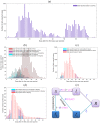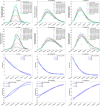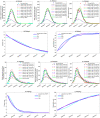Combining the dynamic model and deep neural networks to identify the intensity of interventions during COVID-19 pandemic
- PMID: 37851640
- PMCID: PMC10584194
- DOI: 10.1371/journal.pcbi.1011535
Combining the dynamic model and deep neural networks to identify the intensity of interventions during COVID-19 pandemic
Abstract
During the COVID-19 pandemic, control measures, especially massive contact tracing following prompt quarantine and isolation, play an important role in mitigating the disease spread, and quantifying the dynamic contact rate and quarantine rate and estimate their impacts remain challenging. To precisely quantify the intensity of interventions, we develop the mechanism of physics-informed neural network (PINN) to propose the extended transmission-dynamics-informed neural network (TDINN) algorithm by combining scattered observational data with deep learning and epidemic models. The TDINN algorithm can not only avoid assuming the specific rate functions in advance but also make neural networks follow the rules of epidemic systems in the process of learning. We show that the proposed algorithm can fit the multi-source epidemic data in Xi'an, Guangzhou and Yangzhou cities well, and moreover reconstruct the epidemic development trend in Hainan and Xinjiang with incomplete reported data. We inferred the temporal evolution patterns of contact/quarantine rates, selected the best combination from the family of functions to accurately simulate the contact/quarantine time series learned by TDINN algorithm, and consequently reconstructed the epidemic process. The selected rate functions based on the time series inferred by deep learning have epidemiologically reasonable meanings. In addition, the proposed TDINN algorithm has also been verified by COVID-19 epidemic data with multiple waves in Liaoning province and shows good performance. We find the significant fluctuations in estimated contact/quarantine rates, and a feedback loop between the strengthening/relaxation of intervention strategies and the recurrence of the outbreaks. Moreover, the findings show that there is diversity in the shape of the temporal evolution curves of the inferred contact/quarantine rates in the considered regions, which indicates variation in the intensity of control strategies adopted in various regions.
Copyright: © 2023 He et al. This is an open access article distributed under the terms of the Creative Commons Attribution License, which permits unrestricted use, distribution, and reproduction in any medium, provided the original author and source are credited.
Conflict of interest statement
The authors have declared that no competing interests exist.
Figures







Similar articles
-
Transmission dynamics informed neural network with application to COVID-19 infections.Comput Biol Med. 2023 Oct;165:107431. doi: 10.1016/j.compbiomed.2023.107431. Epub 2023 Sep 1. Comput Biol Med. 2023. PMID: 37696183
-
Digital Contact Tracing Based on a Graph Database Algorithm for Emergency Management During the COVID-19 Epidemic: Case Study.JMIR Mhealth Uhealth. 2021 Jan 22;9(1):e26836. doi: 10.2196/26836. JMIR Mhealth Uhealth. 2021. PMID: 33460389 Free PMC article.
-
The effectiveness of various control strategies: An insight from a comparison modelling study.J Theor Biol. 2022 Sep 21;549:111205. doi: 10.1016/j.jtbi.2022.111205. Epub 2022 Jun 23. J Theor Biol. 2022. PMID: 35753357
-
Contact tracing indicators for COVID-19: Rapid scoping review and conceptual framework.PLoS One. 2022 Feb 28;17(2):e0264433. doi: 10.1371/journal.pone.0264433. eCollection 2022. PLoS One. 2022. PMID: 35226699 Free PMC article.
-
A rapid review of measures to support people in isolation or quarantine during the Covid-19 pandemic and the effectiveness of such measures.Rev Med Virol. 2022 Jan;32(1):e2244. doi: 10.1002/rmv.2244. Epub 2021 May 14. Rev Med Virol. 2022. PMID: 33989440 Free PMC article. Review.
Cited by
-
Integrating artificial intelligence with mechanistic epidemiological modeling: a scoping review of opportunities and challenges.Nat Commun. 2025 Jan 10;16(1):581. doi: 10.1038/s41467-024-55461-x. Nat Commun. 2025. PMID: 39794317 Free PMC article.
-
Integrating dynamic models and neural networks to discover the mechanism of meteorological factors on Aedes population.PLoS Comput Biol. 2024 Sep 27;20(9):e1012499. doi: 10.1371/journal.pcbi.1012499. eCollection 2024 Sep. PLoS Comput Biol. 2024. PMID: 39331695 Free PMC article.
-
Global infectious disease early warning models: An updated review and lessons from the COVID-19 pandemic.Infect Dis Model. 2024 Dec 3;10(2):410-422. doi: 10.1016/j.idm.2024.12.001. eCollection 2025 Jun. Infect Dis Model. 2024. PMID: 39816751 Free PMC article. Review.
-
Leveraging dynamics informed neural networks for predictive modeling of COVID-19 spread: a hybrid SEIRV-DNNs approach.Sci Rep. 2025 Jan 15;15(1):2043. doi: 10.1038/s41598-025-85440-1. Sci Rep. 2025. PMID: 39814760 Free PMC article.
-
A Physics-Informed Neural Network approach for compartmental epidemiological models.PLoS Comput Biol. 2024 Sep 5;20(9):e1012387. doi: 10.1371/journal.pcbi.1012387. eCollection 2024 Sep. PLoS Comput Biol. 2024. PMID: 39236067 Free PMC article.
References
-
- Kermack WO, McKendrick AG. A contribution to the mathematical theory of epidemics. Proceedings of the Royal Society of London. Series A. 1927; 115(772):700–721.
-
- Viguerie A, Lorenzo G, Auricchio F, Baroli D, Hughes TJ, Patton A, et al.. Simulating the spread of COVID-19 via a spatially-resolved susceptible–exposed–infected–recovered–deceased (SEIRD) model with heterogeneous diffusion. Applied Mathematics Letters. 2021; 111:106617. doi: 10.1016/j.aml.2020.106617 - DOI - PMC - PubMed
-
- Atangana A, Araz Sİ. Fractional stochastic differential equations: Applications to Covid-19 modeling. Springer Nature; 2022.
Publication types
MeSH terms
LinkOut - more resources
Full Text Sources
Medical

